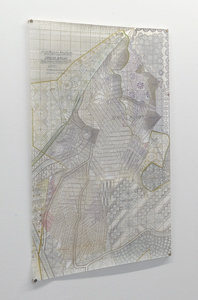
Born in Brest(FR) in 1978. Lives and works in Munich(DE)

2012
Printing on polyester tracing paper, map name in the archives (Frad-57-2431w233-6), gouache.
70 x 121 cm
Year of Purchase: 2012
At first sight, Marta Caradec’s works appear to be decorative: the weaving, tapestry, rug, or heraldic motifs seem to evoke ornamental practice. However, at closer inspection, Marta Caradec seems to be “censoring” maps with obsessive, folk-like imagination evocative of the dense iconography of Wölfli, Lesage, or Crépin, except that Marta Caradec is neither inspired nor spiritual and, unlike the raw artists, is at home in contemporary art as much as in the social reality that informs the use of charts, world maps, or the atlas — informative, yet at the same political and ideological, interpretive tools. Although the artist partially covers up these maps, they nevertheless remain visible, and it is possible to decipher the situations they represent and realize that they have generated what dissimulates them.
Thus, in the series Audun-le-Tiche (2012), maps of the eponymous mining site in the Lorraine region — the last iron ore mine shut down in 1997 and located in the Department of Moselle where the artist spent a residency — are covered with ornamental motifs representing the flow of economic migrations. Every stratigraphic chart of a specific color is arbitrarily associated with the geographic origin of a population (red = Algeria; yellow = Cameroon and Senegal; grey = Portugal, etc.), without the object ever being named except in the title of the work. Another map, Creutzwald (2012), also representing a Moselle locality, is yet another toponym for an active coal mine, and it illustrates the waves of immigration by covering a housing project inhabited by miners and their families with various traditional motifs. In this case, the map is both legible — to anyone able to recognize the patterns — and visible: the patchwork, the interweaving, the intermeshing, the disjunctions and connections are all in plain sight.The same principle applies to Metz en Algérie (2013), the nickname given by French colonizers to the city of Akbou in the aftermath of the annexation of Alsace and Lorraine by Germany in 1871. A map of that city and the surrounding areas, dated 1958, has been covered with various historical, geographical, and cultural motifs: Western medieval motifs juxtaposed with traditional Algerian ceramic, tapestry, or embroidery patterns; a bestiary contrasted with arabesques; chimeras with calligraphy … symbolically evoking the current opposition between the so-called “native” French and the those of North-African descent — except that there is no conflict, but intermixing, integration, fusion in a visual conciliation or reconciliation, in the absence of a political one, and in stark contrast to the context of rising identity populism in which this work was carried out. And this is precisely Marta Caradec’s ambition: to bear witness to the world, to offer a reading of it and provide a utopian place, that of art and culture, as a battlefield.
Éric Suchère